



calcium ammonium nitrate vs calcium nitrate
Understanding Calcium Ammonium Nitrate vs. Calcium Nitrate
When it comes to fertilization in agriculture, choosing the right type of nutrient can significantly impact crop yield and soil health. Two commonly used fertilizers that contain calcium and nitrogen are Calcium Ammonium Nitrate (CAN) and Calcium Nitrate (CN). Both fertilizers play crucial roles in nutrient supply, but they have different compositions, properties, and applications. This article aims to outline the distinctions and similarities between Calcium Ammonium Nitrate and Calcium Nitrate, helping farmers and agriculturalists make informed decisions.
Composition and Chemical Properties
Calcium Nitrate, with the chemical formula Ca(NO3)2, is a compound formed from calcium and nitrate ions. It is a highly soluble and hygroscopic compound, meaning it can absorb moisture from the air. This makes it an effective quick-release fertilizer, supplying plants with readily available calcium and nitrogen.
On the other hand, Calcium Ammonium Nitrate is a dual-nutrient fertilizer that combines both calcium (Ca) and ammonium (NH4) with nitrate (NO3). Its typical composition consists of approximately 27% nitrogen, with a portion being ammonium nitrogen and the balance from nitrate nitrogen, and about 16% calcium. The presence of ammonium in CAN allows for a slightly different release mechanism compared to pure calcium nitrate.
Nutrient Release Dynamics
One of the key differences between the two fertilizers lies in their release dynamics. Calcium Nitrate provides an immediate source of nutrients as it dissolves quickly in water, making it suitable for use during critical growth phases in plants, such as during seedling establishment.
Calcium Ammonium Nitrate, while also effective, releases nitrogen in a more extended timeframe due to the presence of ammonium. Ammonium nitrogen is taken up by plants over a longer period compared to nitrate nitrogen. This characteristic can be beneficial in reducing leaching losses during heavy rainfall or irrigation, as ammonium tends to adhere better to soil particles.
Application and Crops
calcium ammonium nitrate vs calcium nitrate

Both fertilizers are versatile and can be used across various crops, but their applications may vary based on specific growth stages and crop requirements. Farmers often use Calcium Nitrate for crops that demonstrate rapid growth and require immediate nutrient availability, such as tomatoes, cucumbers, and leafy greens.
Calcium Ammonium Nitrate is particularly useful for a wide range of crops, including cereals, fruits, and vegetables. Its balanced nitrogen supply helps enhance overall plant health, improve root development, and increase resistance to disease, thanks to its nutrient profile.
Soil Impact and pH Levels
Another crucial factor to consider is the impact these fertilizers have on soil pH. Calcium Nitrate is known for being neutral in its effect on soil acidity. When applied, it does not significantly alter the pH, making it suitable for a range of soil types and conditions. This quality makes it a widely preferred choice, especially in regions with naturally low pH soils.
Calcium Ammonium Nitrate, however, is slightly acidic due to the presence of ammonium. Its repeated application can potentially lower soil pH over time, which may necessitate periodic liming to maintain optimal growing conditions, especially in sensitive crops that thrive in neutral to slightly alkaline soils.
Cost Considerations
Cost is also a significant factor when choosing between the two fertilizers. Generally, Calcium Ammonium Nitrate tends to be less expensive than Calcium Nitrate, making it an attractive option for budget-conscious farmers. However, price should not be the only consideration; effectiveness in meeting crop nutrient requirements and soil health should weigh equally in the decision-making process.
Conclusion
In conclusion, both Calcium Ammonium Nitrate and Calcium Nitrate provide essential nutrients for plants but differ in their composition, nutrient release dynamics, application methods, impact on soil pH, and cost. Farmers must assess their specific agricultural needs, the type of crops they cultivate, and their soil conditions when deciding which fertilizer to use. By understanding the differences and similarities between these two fertilizers, agriculturalists can optimize their fertilization strategies, leading to healthier crops, better yields, and improved soil health.
-
Why Sodium Persulfate Is Everywhere NowNewsJul.07,2025
-
Why Polyacrylamide Is in High DemandNewsJul.07,2025
-
Understanding Paint Chemicals and Their ApplicationsNewsJul.07,2025
-
Smart Use Of Mining ChemicalsNewsJul.07,2025
-
Practical Uses of Potassium MonopersulfateNewsJul.07,2025
-
Agrochemicals In Real FarmingNewsJul.07,2025
-
Sodium Chlorite Hot UsesNewsJul.01,2025










